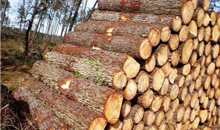Global timber market prices on the fall over the past two years
SEATTLE, Wash. - Prices for global timber have declined dramatically over the past two years with the Global Sawlog Price Index (GSPI) falling 21.6%, according to Wood Resources International. Challenges in the global market, from Asia to Europe, putting a damper on demand include a variety of fundamental economic issues as well as the strengthening U.S. dollar.
SEATTLE, Wash. - Prices for global timber have declined dramatically over the past two years with the Global Sawlog Price Index (GSPI) falling 21.6%, according to Wood Resources International. Challenges in the global market, from Asia to Europe, putting a damper on demand include a variety of fundamental economic issues as well as the strengthening U.S. dollar.
![]()

For the fourth quarter the GSPI fell 4.8%. Prices have fallen the fastest in Europe with the European Sawlog Price Index (ESPI) dropping to its lowest level, US$91.00/m3, since the first quarter of 2009, says Wood Resources.
The U.S. lumber market continues to grow, however, with consumption up nearly 5% and import volumes were also 10% higher. The strong domestic market along with weaker demand from Asia could also mean lower prices for U.S. consumers as availability increases.
Additional numbers on the global forest industry include the following:
Global Pulpwood Prices
• Hardwood fiber prices continued to fall in most of the major pulp-producing countries in the world in the 4Q/15. The biggest declines were seen in Brazil, Chile, Russia, France, Germany and Indonesia. In most regions, the price adjustments were in both in the local currencies and in US dollar terms. The hardwood price index (HFPI) fell 2.2% from the 3Q/15 to US$84.27/odmt.
• With the exception of the US South and New Zealand, softwood fiber prices were also down throughout the world in the 4Q/15. The declines ranged between two to ten percent from the previous quarter. The softwood price index (SFPI), was US$88.46/odmt, a reduction of 1.4% from the previous quarter.
Global Pulp Markets
• Global market pulp production was 3.3% higher in 2015 than in 2014. Production was up in most regions with the exception of Western Europe.
• The biggest increases in pulp export in 2015 were in shipments from Brazil, Canada, the Netherlands and Russia.
• NBSK pulp prices have fallen during much of 2015 but started to find a bottom late in the year. Prices for hardwood pulp (HBKP) started to weaken during the 4Q/15 and prices in Europe were only $15-20/ton lower than those for NBSK.
Global Lumber Markets
• A majority of the 20 largest softwood lumber-consuming countries in the world increased their importation of lumber in 2015, resulting in global trade reaching its highest level in ten years. The US imported 10% more lumber year-over-year and a number of countries in Europe also raised their consumption of imported lumber last year. Lumber demand in Japan, the Middle East and Northern Africa was weaker, resulting in a decline in importation of lumber.
• The US lumber market was a bright spot as compared to most other regions of the world in 2015. Lumber consumption was up almost 5% and import volumes were 10% higher. The strong domestic market and a weakening Asian market also resulted in less lumber being exported.
• Lumber prices in Sweden have fallen 30% from their five-year high in March 2014.
• Although importation of softwood lumber to China fell by two percent in 2015 from the previous year, Russian volumes were up by almost 20 percent year-over-year. Russia is now the largest supplier of lumber to China.
• Demand for wood in Japan has fallen the past two years partly as the result of an eight percent decline in housing starts.
Global Biomass Markets
• North American overseas pellet exports increased for the second consecutive quarter in the 3Q/15, rising 15% from the previous quarter to reach a new record high of just over 1.6 million tons, according to our sister publication North American Wood Fiber Review.
• Although pellet production in Sweden has been fairly stable the past four years, importation has fallen by more than 50% from 2011 to 2015. In the local currency, pellet prices fell during the fall of 2015 and were four percent lower in the 4Q/15 than in the 4Q/14.


 沪公网安备31010402003309号
沪公网安备31010402003309号



